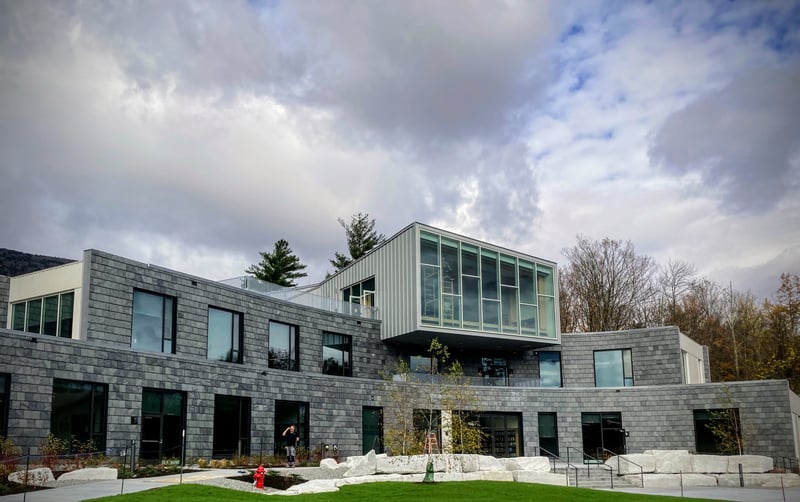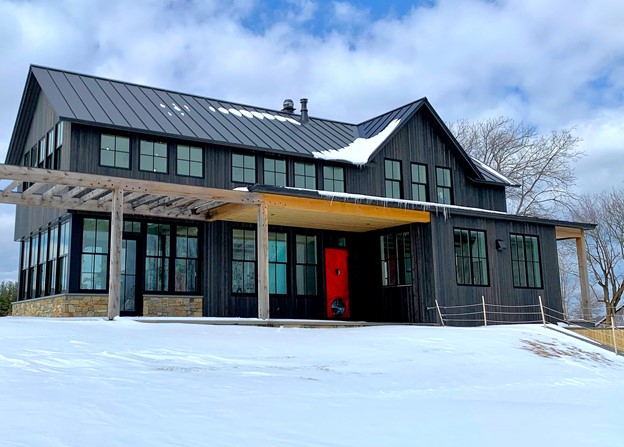Your building’s climate impacts begin with every mechanical, electrical, and envelope system on which it’s built. Identifying effective greenhouse gas (GHG) reduction measures requires an in-depth knowledge of a building’s systems and how they interact. That’s where our decarbonization service can help.

How much can you do with your building? Worldwide, buildings are responsible for 40% of greenhouse gas emissions, meaning owners and operators hold the keys to some of the most powerful and effective climate change mitigation efforts available to anyone. What’s needed is a common understanding of how to move forward.
During a decarbonization audit, we try to answer questions like:
- How efficient is your heating and cooling equipment, and how well does your building envelope perform?
- How much refrigerant exists on-site, and how well do the HVAC systems maintain their refrigerant?
- How coincident is your building’s peak electrical demand with that of your local grid?
- Does your control system include outdoor air reset controls or temperature setbacks, and if so, how effective are they at cutting energy usage?
- Do you have intermittent electrical loads that are not time-sensitive? Is there opportunity for thermal or electrical energy storage on site?
- Do any processes require simultaneous heating and cooling?
- How many vehicles does your business own, and how much do your company’s staff drive? Are any vehicles electric?
- How old is your HVAC equipment? What are you planning to replace in the next five to ten years?
- Are you planning any future building or expansion?
These questions touch many building systems and may seem sprawling or unrelated, but in fact they share a crucial trait: we can quantify their answers in terms of carbon equivalence, or CO2e.
The purpose of a decarbonization audit is just that, to quantify and prioritize HVAC & envelope-related improvement measures by their cost paybacks side-by-side with their effectiveness at drawing down your building’s carbon footprint. But in order to quantify, we need a standard, which I’ll describe in the next section.
Carbon Accounting Framework
Generally, we take our carbon accounting methods from the GHG Protocol, which is a framework maintained by the World Resources Institute (WRI) and the World Business Council for Sustainable Development (WBCSD). The GHG Protocol divides greenhouse gas emissions into three scopes, and it provides living guidance on using these scopes in corporate-level and project-level carbon accounting. The GHG Protocol has seen increasing adoption over the past decade—reportedly used by >90% of Fortune 500 Companies—to the point that last month, the SEC proposed a ruling that would require U.S.-listed companies to disclose climate impacts to investors using the scope methodology, although we might not see this ruling take effect until 2024, if at all.
I want to stress that for most building owners, corporations, and engineers, these standards and protocols are adopted on a voluntary basis. There are few if any regulatory compliance standards, state or federal statutes, technical reference manuals, or other mandates or guidance pertaining to CO2 emissions from the perspective of consumers of fuels, electricity, or material goods. By taking on decarbonization, we are taking up the fight ourselves, and perhaps even anticipating future regulation related to GHG emissions.
For the most part, our work at Cx Associates encompasses Scope 1 and Scope 2 accounting. Here are the most common sources we find in buildings:
Scope 1 |
|
Scope 2 |
|
So that’s Scope 1 and Scope 2. Scope 3 refers mostly to the embodied carbon of raw materials, which (unless you run a manufacturing facility) comes into play primarily with new construction projects. We welcome requests to quantify the embodied carbon of proposed new building materials and to guide you towards low-GHG materials choices as part of our commissioning work. When it comes to HVAC, however, the embodied carbon of your new heat pump will only comprise a very small portion of the heat pump’s lifecycle carbon impacts – especially if it’s replacing an end-of-life fossil fuel boiler or furnace.
Now that I’ve defined our methods, let’s talk action.
So, what can I do?
“Solar on the roof” is the most popular suggestion I get from building owners looking to decarbonize. While solar PV is a key player in the transition to clean power, it might not be the most carbon- or cost-effective decarbonization measure for your building.
Why is that? For one, the electric grid is already transitioning to clean power. Electricity in the U.S. on average is 20% renewable (doubling in the last 15 years) and, if you include nuclear, 40% carbon-free. If you live in a state with a more aggressive renewable portfolio standard (RPS), your electricity is even greener. More solar panels will help, but building owners can usually make a bigger impact by reckoning with the GHG impacts they already have.
For commercial buildings in the Northeast U.S., fossil fuel heating loads remain by far the dominant source of GHG emissions. Switching from gas, oil, or propane to cold climate heat pumps is likely to cut your building’s carbon footprint in half or more. We can help you identify incentives and rebates to lower the upfront cost of the transition.

But decarbonization requires systems thinking, and I want to demonstrate to you our commitment to comprehensive solutions. If we focus too narrowly on beneficial electrification without couching it within the broader decarbonization framework, then we’ll miss two major resulting challenges of clean heat initiatives.
First, heat pumps use refrigerants, which are supposed to stay in the piping but commonly leak. Refrigerants leak as gases, so leaks are difficult to detect, and a chiller or heat pump can leak up to 20% without noticeable impact on its performance. You can see then how a preventive maintenance program with periodic re-charging of refrigerant without refrigerant quantity tracking can enable a heat pump or chiller to leak 20% per year, or 200% – 400% of its total refrigerant charge over its lifetime. Leaks like this have significant climate impacts: one pound of R-410A has a 100-year global warming potential over 2,000-times that of one pound of CO2. Over the life of the heat pump, a leak this size would equate to years of fossil fuel heating of the same space, taking a huge chunk out our decarbonization efforts.
At present, although the EPA has a GHG reporting program covering refrigerant manufacture and imports, there is little in the way of demand-side tracking—yet. With a decarbonization effort that includes refrigerant tracking, we can get ahead of the curve and track the impacts for ourselves.
The second challenge with electrification is in avoiding the dog-piling of peak coincidence that contributes to increased fossil fuel emissions on the electric grid. When it’s cold in Connecticut, it’s also cold in Maine, and the result is that all the heat pumps in our region are working harder at the same time. As we continue to electrify heating and other coincidence-heavy loads (think: everyone gets home from work and plugs in their EVs at the same time), we will continue to exacerbate these demand curves. To make matters more challenging, utilities continue to add non-dispatchable, intermittent renewables to their supply portfolios. We can’t ask the wind to blow harder during the winter evening peaks in the same way that we can ramp a natural gas turbine up and down.
Because of this mounting tension between electric supply and demand curves, the breakthrough implementation of our era will probably not be generation technology, but storage technology. Pumped hydropower and lithium ion batteries are today’s standard supply-side solutions, but energy storage R&D has received bipartisan support and billions in research grants over recent years. And there is increasing adoption of programs using EV batteries as storage assets for the grid.
If you use your imagination, you’ll start seeing demand-side storage opportunities everywhere. Large buildings with effective envelope systems can maintain temperature for hours at a time, allowing them to act as virtual batteries by, for example, rising out of nighttime setbacks with milder ramp-up than the average building, or even reducing the need for much overnight temperature setback altogether. This can make a big difference for the grid (and, if you’re on a time-of-use rate, potentially for your electric bill as well). It’s already common for utilities to offer electric rates that incentivize commercial & industrial customers to shift loads to different times of the day, or even different days of the week, to help flatten the demand curves. If this interests you, then get in touch with us and we can help you identify these rates and run the numbers.
From a utility’s perspective, if your building can help them avoid demand peaks, then you’re also helping them avoid making short-term wholesale power purchases, which often are not considered low-carbon. Carbon accounting in the electric sector is a vastly complex topic that I’d like to address in a future blog post. For now, let me summarize what we know about electrification:
- Fossil fuel heating is unambiguously high carbon. Scope 1 GHG emissions from fossil fuel heating sources are relatively easy to quantify, and they are the most significant source of New England buildings’ GHG emissions at this time. We can and should draw them down.
- In New England, electrification of fossil fuel heating loads adds up to be an effective decarbonization strategy, even using very conservative (high-carbon) electricity emissions factors (see my white paper on this).
- At the same time, electrification of heating loads contributes to grid peaks. Utilities attempt to buy clean power supply to match these peaks, but anticipating them is difficult.
By engaging in an energy efficiency or load-shifting program, you can control your building’s electric loads to reduce emissions from high-carbon peaker plants on the grid – even if your utility is not technically buying that dirty power at that moment. Load-shifting and energy efficiency have real effects to their local electric grids, even if our current renewable energy credit (REC) tracking system is not set up to quantify those effects. Again, I’ll attempt to explain further in a future blog post.

Summary
If there’s one theme to decarbonization in 2022, it’s that it’s up to us.
It’s up to us to choose standards for carbon accounting (for now), and to stick to these standards. It’s up to us to quantify, prioritize, track, and report. And it’s up to us to draw down the carbon footprints of our buildings.
So, let’s start with your goals. How can we help you kick fossil fuels? Are you looking to achieve carbon neutrality by offsetting your carbon footprint? Or are you in a position to pursue a more aggressive 24/7 carbon-free goal? What is your time frame and budget? What other plans do you have for your building?
Finally, what kind of planet do you want to leave behind?



